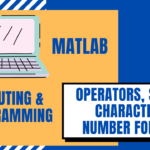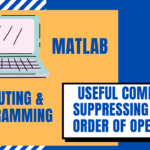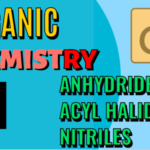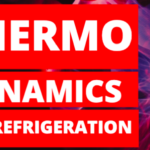Author: neha.bhagirath
-

Operators, Special Characters, Number Formats, Data Types
In today’s lesson, we will discuss the following topics: 1. Operators 2. Relational Operators 3. Logical Operators 4. Special Characters 5. Number Formatting and Converting Between Format Types 6. Data Types and Converting Between Them Operators Operators are symbols in MATLAB. When we use operators, MATLAB understands these symbols to execute a certain operation. For…
https://www.petwantsclt.com/petwants-charlotte-ingredients/ Read more...
-

Mathematical Built-In Functions, Predefined Constants, Adding Comments
https://www.circologhislandi.net/en/conferenze/ Today’s lesson will cover adding comments to your code + built in functions in MATLAB. First, there are two commands that can pull up full lists of built-in elementary and special functions, respectively. Built in function means the command is already “built-in” to MATLAB, so if you type it out MATLAB will know what you…
-

Useful Commands, Controlling Order of Operations, Suppressing Outputs
http://economiacircularverde.com/que-es-la-economia-circular/ Today’s lesson will the following topics: 1. Useful Commands 2. Suppressing Outputs using Semicolon 3. Controlling Order of Operations Useful Commands (a) “clc” : Clears the Command Window. Check out the 3 images below (read the captions) (b) “clear all” or “clear” : Clears all variables from the workspace. Check out the captions on the…
-

Creating and Overwriting Variables
In today’s lesson, we are going to be discussing the following topics: 1. What is a variable? How is it created? 2. Using Variables in Problems 3. Overwriting Variables What is a Variable? A variable is a word or letter that stores a value (a number) within it. This is so we can use it…
-

Introduction and Installation, Error Messages, Using Calculator
In today’s lesson, we will be discussing an introduction to MATLAB. The following topics will be covered: 1. What is MATLAB? 2. Installation 3. Starting and Exiting 4. Basic Calculations 5. Error Messages What is MATLAB? How did it become MATLAB? It is a computational/technical software, and is usually taught in engineering classes. It stands…
-

Putting it All Together – Trickier Examples
In today’s lesson, we will use what we previously learned in this chapter to put together names and drawings of trickier organic compounds. Here’s what we learned so far (if you are not up to date with all of these, please check out the previous blog posts before heading to this one): (a) Drawing Skeletal…
-

Nomenclature and Properties of Anhydrides, Acyl Halides (eg. Acid Chloride), Nitrile
In today’s lesson, we are going to discuss nomenclature and properties of the following organic functional groups: 1. Anhydrides 2. Acyl Halides (eg. Acid Chlorides) 3. Nitriles Anhydrides Note: “Anhydrides” and “Acid Anhydrides” are different names for the same family. Anhydrides are compounds that have 2 carbonyl groups separated by an Oxygen in the shape.…
-

Nomenclature and Properties of Amines, Amides, and Heterocyclic Compounds
In today’s lesson, we are going to discuss nomenclature and properties of the following organic functional groups: 1. Amines Nomenclature 2. Amides Nomenclature 3. Heterocyclic Compound Nomenclature 4. Amine Properties 5. Amide Properties Amines Nomenclature Amines are a functional group that contains a nitrogen with a lone pair of electrons (which are always there, but…
-

Nomenclature and Properties of Carboxylic Acids, Alcohols, Thiols, Ethers, Thioethers, Esters
In today’s lesson, we are going to discuss nomenclature and properties of the following organic functional groups: 1. Carboxylic Acids 2. Alcohols 3. Thiols (Sulfur Alcohols) 4. Ethers 5. Thioethers 6. Esters Carboxylic Acids Carboxylic acids are a carboxyl group in their shape. I have highlighted the carboxyl group below: When we name these, we…
-

Gas Refrigeration (aka Reverse Brayton/Bell Coleman/Reverse Joule) Cycle + Regenerative Cooling
In today’s lesson, we are going to discuss the following topics: 1. Gas Refrigeration Cycle, otherwise known as the Reverse Brayton, Reverse Joule, or Bell Coleman Cycle 2. Equations 3. T-S Diagrams 4. Refrigeration Example 5. Regenerative Cooling VIDEO COMING SOON Notes and Assumptions: (a) This whole process is internally reversible. (b) There is no…
Recent Posts
- More Practice – Thermodynamics
- More Practice – Advanced Functions
- How Genetic Algorithms Evolved From the Theory of Evolution

- More Practice – Process Design
- More Practice – Process Integration
Tags
absorption acid alcohol alphabetical order benzene calculus carbon chemical chemistry computing conjugate cyclo definite differential engineer engineering equations exceptions exponential factoring families Gaussian Elimination graphs identity indefinite limit rules limits logarithmic math MATLAB nomenclature organic phenyl programming properties reversed carnot Row Reductions rules squeeze theorem substituents System of Equations table of values trig university vapor compression
Comments
Hello there. I discovered your site by means of Google at the same time as searching for a similar subject,…
thanks!